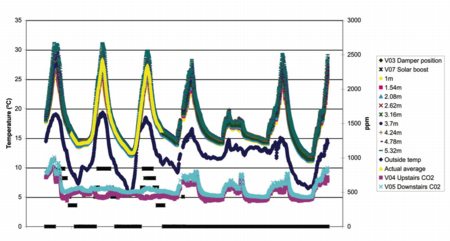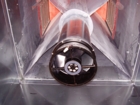BSRIA tests solar-assisted natural ventilation

Positioned immediately about the double-height entry foyer of BSRIA’s building is the Monodraught Sola-boost ventilation unit.
Controlling the indoor environment using natural ventilation is generally regarded as ‘greener’ than air conditioning — but how effective is using solar energy to give it a boost? Ken Sharpe was given the chance to look at a project at BSRIA.There are two principal objectives to be achieved when applying natural ventilation to a building. One is to maintain indoor air quality by keeping down the levels of carbon dioxide. The other, and one which is becoming increasingly important, is to control indoor temperatures without the high capital and operating costs associated with mechanical air conditioning. For many years, Monodraught WindCatcher systems have been installed in both new and retrofit projects for both purposes. In response to the growing role of WindCatchers to prevent the build-up of excessive temperatures in buildings, Monodraught developed the option of fitting WindCatchers with a solar-powered fan to provide a significant boost to the ventilation rate when the Sun is very bright — which of course, is when a higher ventilation rate is required. Whereas the capabilities of the conventional WindCatcher installation at the University of Hertfordshire were independently monitored and reported on by BRE in 1998, the newer Sola-boost had not been subject to the same scrutiny — until BSRIA approached Monodraught to install a unit to cool the overheating entry foyer in its office building at Bracknell. Dr Arnold Teekaram, a principal research engineer with BSRIA responsible for this project tells us that during the summer, temperatures in the entry foyer at high level could reach up to 40°C. The area has three heat-pump units fitted from the original construction in 1982, which are now at the end of their life. The reception area also houses the main staircase to the upper floor, so it is a double-height space. Sited on a corner of the building, it is glazed from floor to roof on its two sides, which face virtually south and west. Although Venetian blinds are a help, the glass does not provide any significant solar control. In sizing the single Sola-boost natural-ventilation unit, Monodraught took into account the extensive glazing, the usual single occupancy (80 W) with computer (125 W) and printer (200 W), lighting (10 W/m2) and air leakage estimated at 0.2 air changes an hour. The reception has a floor area of 42 m2 and is 6.9 m high. It has 45 m2 of south and south west facing glazing with a solar-shading factor of 0.3. The overall heat gain to be ventilated was calculated by Monodraught at 6.7 kW. Maintaining an internal temperature 5 K above the outside temperature requires a ventilation rate of 13.7 air changes an hour. Of that figure, Monodraught estimated 0.2 air-changes an hour are provided by air leakage, leaving 13.5 air changes an hour to be provided by the Sola-boost unit. With a conservatively estimated wind speed of 2 m/s, a 1200 mm-square Sola-boost unit would provide 12.2 air changes an hour, with the Sola-boost fan providing a further 2 air changes an hour, or 260 l/s in bright sunshine — even with no wind. Ventilation can be controlled by opening and closing dampers within the unit.

Early results from the Monodraught Sola-boost ventilation unit installed at BSRIA illustrate its effect on indoor temperature with damper-controlled operation (see text).
A Monodraught team installed the unit, having first investigated the internal roof structure. Structural steel work on a spacing of about 1.5 m supports a colour-coated corrugated sheet-metal roof with a shallow pitch of 2 to 3°. Unfortunately, when it came to monitoring the effect of the unit on internal temperatures we had a very poor summer. However, the week from 26 September to 3 October was a warm spell, with external temperatures approaching 20°C by mid-afternoon, and useful results were obtained. Indoor temperatures were measured every five minutes at nine heights from 1 to 5.32 m and compared with the outdoor temperature. The horizontal black lines in the graph show the damper position, the lowest lines being the damper fully closed, the highest lines fully open, and the intermediate lines partly open. The graph in this article is at such a scale that it is difficult to discern the detail, but the visible yellow line is from 27 September to 29 September and is the indoor average over the nine heights and shows clearly how the internal temperature can be controlled. Following this limited period of monitoring, Dr Teekaram is looking forward to next Spring and Summer to resume work. A crucial part of the temperature-control strategy during warm weather is to open the damper in the Sola-boost to cool the building overnight, while not allowing the internal temperature to fall below 15°C. During the day, the damper will be controlled as required, and the solar-powered fan will be brought into operation to provide additional air movement and cooling. The early measurements have already enabled an equation to be derived to calculate the indoor temperature for outdoor temperatures from 5 to 20°C with a good level of confidence. The equation is: y = 0.633x2 – 0.5617x + 14.375 We were shown the installation by Professor Terry Payne, Monodraught’s managing director, on a cool day at the end of October. With no regard for the comfort of the receptionist(!) he made use of the controller at first-floor level to demonstrate the unit with the damper open, with and without the solar powered fan operating to increase the airflow rate He pointed out that with it being relatively cold outside, since it was the end of October, and relatively warm inside, one might expect the WindCatcher system to act purely as a passive stack to vent hot air from the building. However, that expectation was refuted on site, and it was very clear that there was sufficient downflow of incoming cold air to be felt at floor level with the damper open — and even more so with the fan operating. The BSRIA researchers on this project are looking forward to a good summer next year — for more than one reason.

When the Sun shine, the solar-powered fan in the Monodraught Sola-boost unit increases the ventilation rate by 260 l/s.
Related articles:










